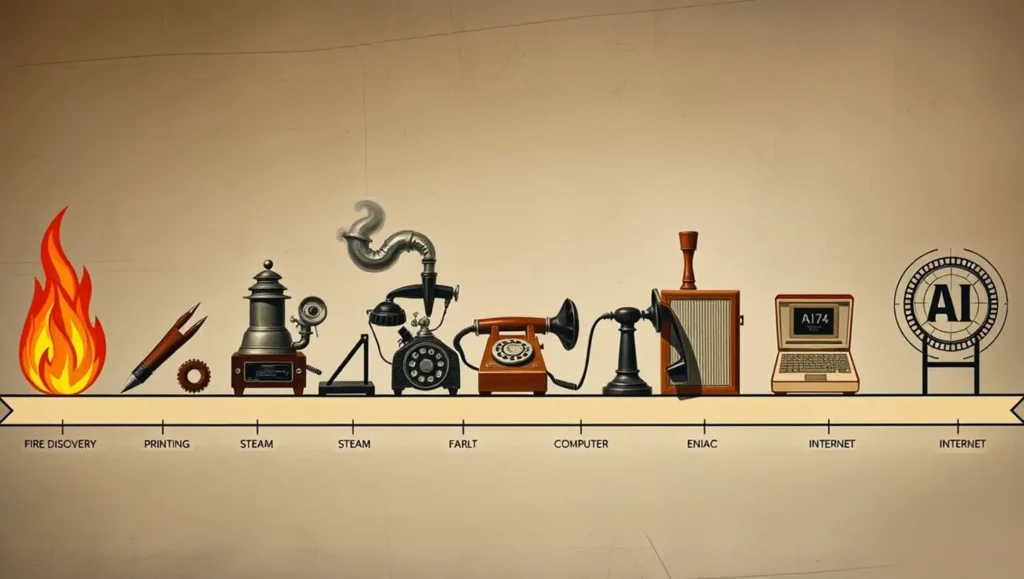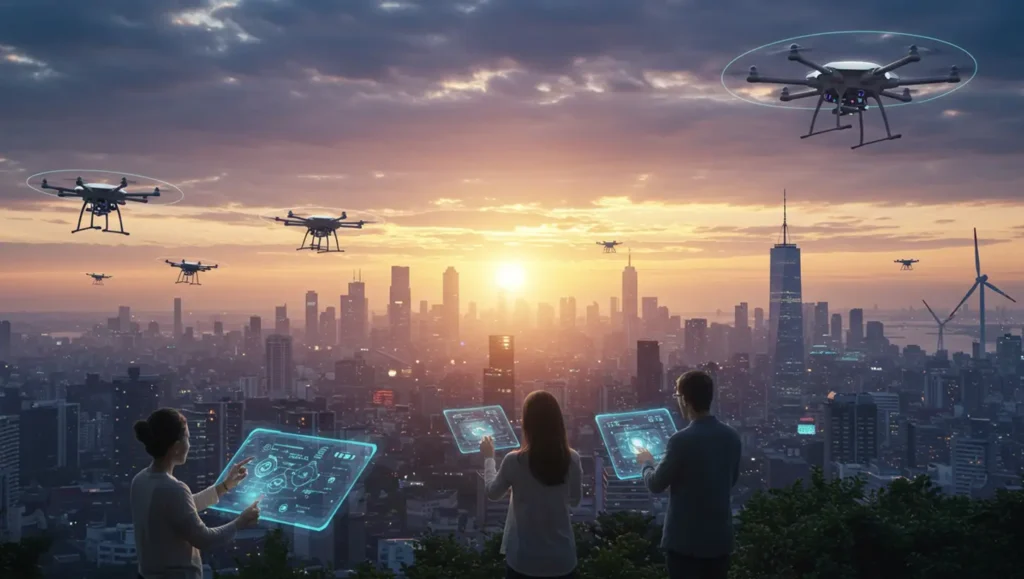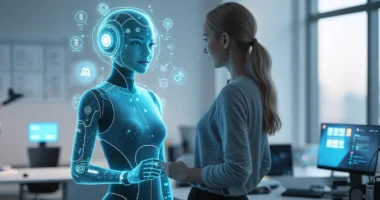From the alarm clock that wakes us up to the smartphone we check before bed, technology pervades every second of our day. But have you ever stopped to consider how radically different our world is from merely a few decades ago, much less centuries past? One of the most intriguing chapters in human history, the narrative of the development of technology is full of breakthrough discoveries, revolutionary creations, and amazing adaptations that have drastically changed our life, work, and relationships with one another.

Knowing this technological trajectory is not only about satisfying our need on the past; it’s critical for understanding our current and getting ready for our future. Roots going back hundreds of years of human creativity may be found in every device in our pocket, every medical breakthrough that saves lives, and every challenge we face in our digital age. By looking at how technology has developed and changed society, we can better understand both the amazing advantages we have now and the difficult hurdles we have to negotiate going ahead.
Through Time: Notable Technical Milestones
Human technological development starts much earlier than most of us believe. 3.3 million years ago, our forefathers fashioned basic stone implements, marking humanity’s first foray toward changing the planet around us. From the uncovering of fire about 1 million years ago to the agricultural revolution that would fundamentally alter human society, these basic yet powerful tools paved the path for all that would come afterward.

One of the most important technological advancements of mankind, the Agricultural Revolution took place about 10,000 years ago. The domestication of animals, the creation of agricultural methods, and irrigation systems helped humans to change from nomadic huntergatherer communities to more permanent settlements. This metamorphosis not only changed how people got food but also completely changed social systems, resulting in sophisticated labor, trade networks, and the emergence of sophisticated societies.
Fast forward to more current centuries, and the speed of invention started increasing fast. Transport and commerce were changed by the wheel’s 3500 BC discovery. Developed in the 15th century, the printing press revolutionized civilizations and made knowledge more democratic. Another watershed event, the Industrial Revolution of the late 18th century brought steam engines, mechanised manufacturing, and radically changed social and economic terrain.
The 19th and early 20th centuries saw an explosion of lifealtering innovations. The telephone developed by Alexander Graham Bell in 1876 transformed communication by enabling real-time chats across enormous distances. The world was literally lit in 1879 by Thomas Edison’s electric light bulb, therefore altering daily living and employment. Originally created by Karl Benz in 1886, the car gave people never-before-seen mobility and freedom.
The computer age arrived in the middle of the 20th century. Constructed in 1945, ENIAC, the first contemporary computer, paved the ground for the digital revolution to come. The development of the internet in the 1960s into a worldwide network changed how we access information and interact. Personal computers were becoming home goods by the 1990s, and the World Wide Web was creating totally new options for human interaction and knowledge sharing.
Mobile technology and artificial intelligence have ushered us into the 21st century. Our mobile devices have evolved into strong computers allowing us to instantly contact with people anywhere in the globe and connect to almost limitless information. While artificial intelligence is starting to enhance human capacities in ways that were once only science fiction, social media platforms have generated fresh kinds of worldwide community.
Audible is an Audio Books Platform, where you can find any audio book of your interests including Stories, Histories and much more. Try Audible 100% FREE for 30 days, Click Here to Subscribe today .

How Daily Life Has Been Changed by Technology
The good effects technology has on our everyday life are so great it’s hard to envision living without them. Technologically speaking, our lives are more effective, networked, and practical in ways past generations could have never imagined.

Probably the most radically changed area of human life is communication. Our forefathers depended on handwritten letters that needed weeks to reach their destination; today we dispatch messages everywhere instantly. Social media channels let us interact with likeminded people independent of geographic constraints, while video conferencing lets us keep facetoface connections with those thousands of miles distant. Millions of people depended on digital platforms to keep in touch with relatives, friends, and colleagues during lockdowns, therefore proving how vital these technologies have become during the COVID19 pandemic.
Thanks to technical progress, healthcare has undergone transformational developments. Thanks to AId-driven medical analysis, early disease detection that can save many lives is now made possible by contemporary medical technology, which also helps to identify illnesses more readily using MRI and CT scans. By enabling patients to get medical consultations from the convenience of their houses, telemedicine has improved access to healthcare. Millions of people with impairments or health problems have had their quality of life enhanced by robotic surgery, artificial joints, and cardiovascular implants.
Technology has totally transformed transportation. While ride-sharing apps like Uber and Lyft have changed metropolitan mobility, GPS navigation tools enable us to quickly find our route. Travel has become more seamless and consistent thanks to real-time traffic reports and route optimization. While autonomous vehicle technology aims to make transportation safer and more accessible, electric cars are starting to solve environmental issues.
Technological advancements have helped to democratize education. Online learning platforms remove economic level and geographic restrictions by offering knowledge from everywhere on Earth. Learning has become more customized and engaging thanks to digital technologies and educational programs. Technology made it possible to continue education throughout the epidemic when conventional classrooms became impractical.
Smart technology has made daily duties simpler and more effective at our houses. Smart home systems let us remotely manage appliances; devices like robot vacuums and smart thermostats automatically take care of regular maintenance. Personalized recommendations and contactless payment choices have brought the market of the whole world to our fingertips, therefore making buying more practical than ever.
The Darker Side: Problems and Bad Effects
Still, this technological utopia presents serious problems society struggles with continuously. Though technology has brought about great advantages, it has also brought about new difficulties that profoundly impact people and communities.

One of the most urgent issues of the technological age is job displacement. Automation and artificial intelligence are becoming more complex, therefore displacing human employees in many sectors. Particularly hit have been manufacturing jobs; robots have replaced millions formerly employed on assembly lines. With artificial intelligence systems becoming more able to handle financial, legal, and even journalism work, this tendency is spreading from manual labor into whitecollar occupations. The worry relates to the wider effects on the labor market and rising income inequality, not only about job losses right away.
Privacy and cybersecurity issues have grown to be rather important ones in our connected society. The great quantities of personal information gathered by technology companies begs big concerns about how this data is kept safe and used. Millions of people’s confidential data have been exposed in data breaches, which has resulted in financial losses and identity theft. Through regular monitoring of our actions, social media sites and electronic devices produce thorough profiles that could be abused for discrimination or manipulation. The boundary between monitoring and convenience has grown more hazy.
Unexpectedly, mental health and social interactions have deteriorated. Especially among young people, too much screen time has been connected with depression, anxiety, and attention problems. The continuous connection that smartphones and social media provide can cause addictive habits and reduced capacity to concentrate. Paradoxically, while technology has made worldwide communication easier, it has also decreased face-to-face contacts and undermined local community ties.
A major modern society problem is the dissemination of false information. The same technologies that enable more equal access to information also simplify dissemination of erroneous or misleading information. Algorithms for social media may produce echo chambers that polarize groups and strengthen current ideas. This has great ramifications for social cohesion, public health decisions, and democratic procedures.
Our ever sedentary, screen-based lifestyles have caused physical health issues. Common health problems include text neck from continuous downward glances at devices, eye strain from extended screen exposure, and obesity from decreased physical activity. Blue light from screens affects sleeping habits, while constant stimulation from digital devices can interfere with normal sleep cycles.
Environmental challenges offer another major barrier. Although technology can assist in solving environmental issues, the manufacture and disposal of electronic gadgets have significant environmental consequences. Because technology obsolescence happens so quickly, flawless functioning gadgets are frequently thrown away, therefore adding to rising electronic garbage issues.
Society’s Amazing Capacity for Adaptation
Notwithstanding these problems, the degree to which human society has adjusted to significant shifts makes the technology narrative quite amazing. Throughout history, civilizations have shown remarkable flexibility in adapting to new technologies and often discovered means to maximize benefits while producing plans to mitigate adverse effects.

Generally speaking, technology adaptation follows rather regular patterns. Studies reveal that when emerging technologies replace rather than augment human capacity, society often rejects them. People, however, will embrace technologies that assist needs for inclusion, meaning, difficulty, and purpose. This helps to clarify why certain ideas meet resistance while others are swiftly accepted.
Adopt of technology depends much on social support networks. Often acting as bridges assisting elderly people to negotiate new technologies are family members, particularly younger generations. Learning and adaptation need critical support from peer networks and community groups. Professional support and educational possibilities guarantee that more sectors of society benefit from technology.
Historical data show how flexible society is. Many people feared the telephone would eventually replace face-to-face communication when it was initially introduced. Instead, people found methods to include phones into social life while still engaging in old forms of communication. Though initially the internet presented same problems, humanity has created both technological solutions (like privacy tools) and societal standards (like digital etiquette) to solve many of these problems.
Government and organizational replies have changed to meet technical difficulties. While educational institutions have produced digital literacy programs to enable individuals to navigate technology complexity, governments have created new legal frameworks like GDPR to safeguard digital privacy. To encourage responsible innovation and solve society issues, sectors have set norms and best practices.
Particularly striking has been economic adaptation. Though technology has eliminated some jobs, it has also produced completely new sectors and career paths. To enable workers to adjust to changing economic conditions, society has created retraining programs, lifetime learning projects, and social safety nets. Enabled by digital technologies, remote work has presented fresh possibilities for financial inclusion and life balance.
Cultural adaptation reveals how civilizations embrace technology while yet upholding their beliefs. Various societies have discovered original means to employ technology fit with their social values and priorities. Mobile money transfer systems created in Kenya, for instance, have grown throughout Africa to show how technical creativity can be modified to meet local needs and circumstances.
Looking Toward the Future
The narrative of how technology affects society is far from over as we stand at the threshold of an age defined by artificial intelligence, quantum computing, and biotechnology. With ideas that once took decades to create now appearing in only a few years, the rate of technical change keeps accelerating.

Perhaps the most important technological frontier we confront right now is artificial intelligence. AI may totally transform everything from education and healthcare to transportation and scientific research. It also brings up great issues about the future of labor, privacy, and human freedom. Society will have to use AI’s advantages while also tackling its hazards by means of careful governance, moral frameworks, and inclusive development procedures.
The lessons from our technological past offer great direction for negotiating these next hurdles. Along with technical invention, successful technology adoption calls for social adaptation, institutional support, and inclusive methods guaranteeing widely distributed advantages. The track record of society indicates that while new technologies will certainly present fresh problems, human innovation and adaptability will keep finding answers for them.
Maintaining the balance between invention and humanity is the secret to a bright technological future. Most likely to be welcomed by society are technologies that enhance rather than replace human skills, foster inclusion rather than division, and solve real problems rather than creating new ones. The objective should be to make sure that technical advancement enhances human dignity, reinforces communities, and offers chances for all people to flourish going forward.
Ultimately, the history of technology and society is one of human invention, resiliency, and adaption. From stone tools to cell phones, from the printing press to the internet, every technological revolution has radically changed our way of life while exposing fresh facets of human nature and possibility. Although the problems are actual and considerable, history points to the fact that societies can effectively negotiate technical advancement if they approach it with knowledge, inclusion, and a dedication to human well-being.
The decisions we make today on how to develop, distribute, and regulate new technologies will define the world our grandkids will inherit as we write the next chapters of this technical narrative. Understanding our current problems, learning from our past, and working together for common goals will help us to guarantee that technology keeps serving humanity’s greatest aspirations while also meeting our most urgent needs.
Though one thing remains constant—our ability to adapt, innovate, and discover means to use our tools in support of human thriving—the connection between technology and society will continue to change. At their heart, this amazing tale of technical change honors the amazing capacity of human imagination and our infinite ability to conceive and create a better world.
Read Article about “Discover Agentic AI: Your New Smart Assistant in 2025” Click Here







